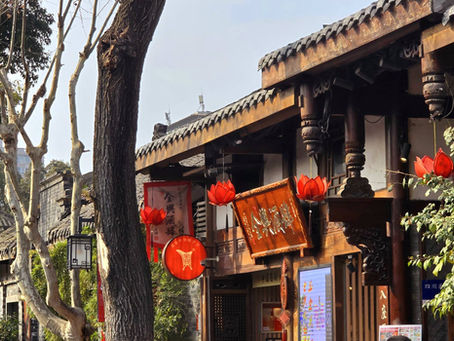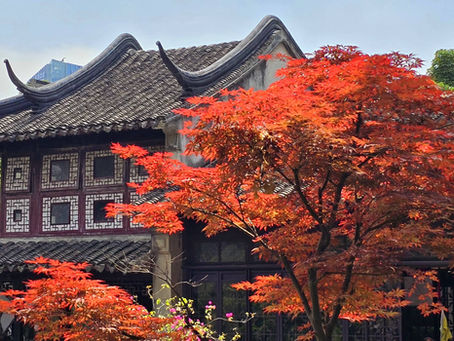top of page

GLOBAL SHANANIGANS

Search


Elephant Trunk Hill
At the confluence of the Li and Taohua Rivers, Elephant Trunk Hill stands as a silent guardian of Guilin, a natural sculpture shaped by time and legend. Said to be the petrified form of a celestial elephant struck down by the Heavenly Emperor, it blurs the boundary between myth and geology. For over a thousand years, poets and monks have carved their reverence into its stone, honouring its enduring spirit of wisdom and compassion.
Shannon


Hangzhou West Lake
Shrouded in mist and legend, West Lake stretches like liquid silver across Hangzhou, a place that has inspired poets, Emperors and travellers for centuries. What began as a humble lagoon more than 1800 years ago was transformed by human hands into a shimmering masterpiece. Today, as a UNESCO World Heritage site, the lake’s serene surface hides centuries of ambition, artistry and whispered secrets.
Shannon


Chengdu Night Cruise
Founded by the Kingdom of Shu in the 4th century, Chengdu and the Jinjiang River served as a crucial intersection to three trade corridors for the Silk Road. In 316AD it was established as the Capital under the Qin Dynasty and was not only a key centre for trade but became renowned for its music, poetry and cuisine.
Shannon


Kuanxiangzi Alley & The Blood Lantern Widow
Tucked into the vibrant heart of Chengdu, the capital of Sichuan Province, Kuanxiangzi Alley is a rare remnant of Qing Dynasty urban design, its origins reaching back over 300 years. Established in the late 17th century, the alley was constructed over an ancient military garrison and gradually developed into an elite residential area.
Shannon


Meijiawu Tea Village - Tea of the Emperors
Tucked into the misty hills near Hangzhou’s famous West Lake, Meijiawu is more than just a tea village, it’s a living testament to China’s centuries old relationship with tea. The name "Meijiawu" translates to "The Village of the Mei Family," pointing to a 600-year lineage of hand cultivating tea that began with the Mei clan and continues to thrive today. Over time, this small village grew into a national symbol, with its identity and prosperity deeply intertwined with tea cu
Shannon


The Lingering Garden
In a city celebrated for its canals, silk and scholars, Suzhou’s Lingering Garden represents a pinnacle of classical Chinese garden design. Often referred to as one of the “Four Great Classical Gardens of China,” it embodies centuries of artistic refinement and philosophical thought. Built in 1593 during the Ming dynasty by Xu Taishi, a high-ranking official who sought retirement and tranquility, the garden stands as a personal reflection of his scholarly ideals.
Shannon


Empire of Blood - The Violent Rise of Shanghai
Shanghai’s origins date back over a thousand years but its transformation from a modest fishing village to one of the world’s largest metropolises is marked by turmoil and bloodshed. The area was initially a small settlement under the Song dynasty between 960 - 1279AD, primarily a fishing and textile hub.
Shannon


Yu Garden - The Heart of Old Shanghai
Located in Shanghai's historic Old City near the City God Temple, Yu Garden is one of the best preserved examples of classical Chinese garden design. It was originally constructed in 1559 during the Ming Dynasty by Pan Yunduan, a high ranking imperial officer. Pan built the garden as a retirement retreat for his aging father, Pan En, intending it to be a place of comfort and tranquility. The name Yu itself means peace and contentment, symbolising his filial piety.
Shannon


Jingjiang Princes’ Palace
The Jingjiang Princes’ Palace, constructed in 1372 during the early Ming Dynasty, served as the residence of Zhu Shouqian, a nephew of the dynasty’s founding Emperor Zhu Yuanzhang. Perched at the foot of Duxiu Hill in Guilin, the palace was more than just a lavish estate, it embodied the Ming strategy of installing Vassal Kings across the Empire to maintain dynastic stability and guard the frontiers.
Shannon


Yaoshan Mountain - The Roof of Guilin
Yaoshan Mountain scenic area, standing at 909 metres, received its name in 221 BC with the construction of the Yao Emperor Temple at its summit. As the tallest peak in the Guilin region, it offers breathtaking panoramic views of the surrounding karst landscape, limestone formations that define the area’s iconic scenery. This early naming coincided with the unification of China under the Qin Dynasty, marking Yaoshan as a site of both natural prominence and emerging cultural si
Shannon


Zhangjiajie Glass Bridge
When the Zhangjiajie Glass Footbridge opened to the public in August 2016, it instantly shattered world records as the highest and longest glass bottomed suspension bridge. Stretching 430 metres across and suspended 300 metres above the Zhangjiajie Grand Canyon, it connects the dramatic cliffs of Yuanjiajie and Tianzi Mountains, terrain said to have inspired the floating mountains in Avatar.
Shannon


Reed Flute Cave
The Reed Flute Cave, or Ludi Yan as it is known locally, has a fascinating history that stretches back over 1200 years, beginning during the Tang Dynasty. This 180 million year old karst cave complex, located in Guilin, has long been a symbol of natural beauty and historical significance. Its geological formations are a breathtaking testament to the slow, steady power of time, yet its human history is just as remarkable.
Shannon


Suzhou - Whispers on the Water
Set in the heart of Jiangsu Province, Suzhou is often called the “Venice of the East”, a poetic nickname but one that barely scratches the surface. Suzhou is more than romantic, it’s resilient. Its story spans dynastic splendour, foreign intrusion, civil war and a remarkable cultural revival. Founded over 2500 years ago during the historical Spring and Autumn Period, the city was once known as Wu.
Shannon


Tiananmen Square
Located in the heart of Beijing, Tiananmen Square was originally constructed in 1651 under directive from the Ming Dynasty, as a grand gateway and community plaza leading to the Forbidden City. It underwent significant expansion through the establishment of the People's First Republic of China during the tumultuous 1950's.
Shannon


The Sun and Moon Pagodas
The elegant twin structures, known as the Sun and Moon Pagodas, were built to enrich the cultural and visual charm of Guilin’s renowned Two Rivers and Four Lakes scenic area. Set upon the calm waters of Shan Lake, these pagodas create a mesmerising scene, their mirrored reflections dancing on the lake’s surface. They stand as symbols of harmony and offer a stunning example of traditional Chinese design in perfect balance with the surrounding landscape.
Shannon
bottom of page